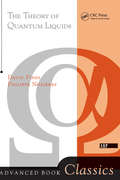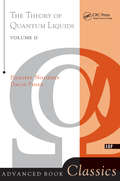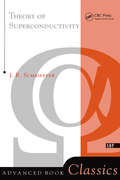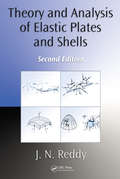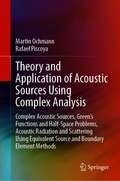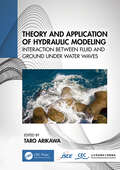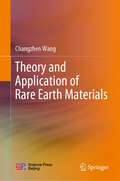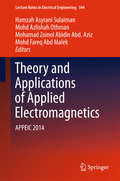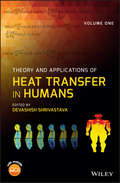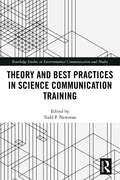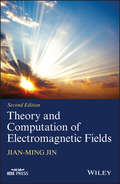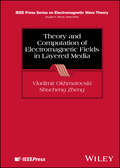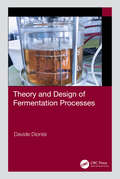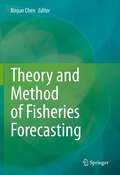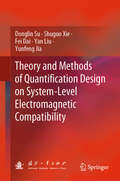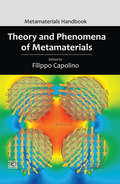- Table View
- List View
Theory Of Quantum Liquids
by Philippe Nozieres David PinesOriginally published as two separate volumes, The Theory of Quantum Liquids is a classic text that attempts to describe the qualitative and unifying aspects of an extremely broad and diversified field. Volume I deals with 'normal’ Fremi liquids, such as 3He and electrons in metals. Volume II consists of a detailed treatment of Bose condensation and liquid 4He, including the development of a Bose liquid theory and a microscopic basis for the two-fluid model, and the description of the elementary excitations of liquid HeII.
Theory Of Quantum Liquids
by Philippe Nozieres David PinesOriginally published as two separate volumes, The Theory of Quantum Liquids is a classic text that attempts to describe the qualitative and unifying aspects of an extremely broad and diversified field. Volume I deals with 'normal' Fremi liquids, such as 3He and electrons in metals. Volume II consists of a detailed treatment of Bose condensation and liquid 4He, including the development of a Bose liquid theory and a microscopic basis for the two-fluid model, and the description of the elementary excitations of liquid HeII.
Theory Of Quantum Liquids
by Philippe NozieresThis volume is devoted to the theory of superfluid quantum liquids, describing the Landau theory of a neutral Fermi liquid in order to illustrate, in comparatively elementary fashion, the way both quantum statistics and particle interaction determine system behavior.
Theory Of Quantum Liquids: Normal Fermi Liquids
by David PinesOriginally published as two separate volumes, The Theory of Quantum Liquids is a classic text that attempts to describe the qualitative and unifying aspects of an extremely broad and diversified field. Volume I deals with'normal' Fremi liquids, such as 3He and electrons in metals. Volume II consists of a detailed treatment of Bose condensation and liquid 4He, including the development of a Bose liquid theory and a microscopic basis for the two-fluid model, and the description of the elementary excitations of liquid HeII.
Theory Of Quantum Liquids: Superfluid Bose Liquids
by Philippe NozieresOriginally published as two separate volumes, The Theory of Quantum Liquids is a classic text that attempts to describe the qualitative and unifying aspects of an extremely broad and diversified field. Volume I deals with'normal' Fremi liquids, such as 3He and electrons in metals. Volume II consists of a detailed treatment of Bose condensation and liquid 4He, including the development of a Bose liquid theory and a microscopic basis for the two-fluid model, and the description of the elementary excitations of liquid HeII.
Theory Of Superconductivity: Theory And Experiment
by J. Robert SchriefferTheory of Superconductivity is considered one of the best treatment of the field. This monograph, by Nobel Prize-winning physicist J. Robert Schrieffer, has been reprinted because of its enduring value as an introduction to the theory of superconductivity. The fundamentals of the theory of superconductivity are stresses as a means of providing the reader with a framework for the literature in which detailed applications of the microscopic theory are made to specific problems. It also serves as a foundation for the more recent development in this active field.
Theory and Analysis of Elastic Plates and Shells (Series in Systems and Control)
by J. N. ReddyBecause plates and shells are common structural elements in aerospace, automotive, and civil engineering structures, engineers must understand the behavior of such structures through the study of theory and analysis. Compiling this information into a single volume, Theory and Analysis of Elastic Plates and Shells, Second Edition presents a complete
Theory and Application of Acoustic Sources Using Complex Analysis: Complex Acoustic Sources, Green’s Functions and Half-Space Problems, Acoustic Radiation and Scattering Using Equivalent Source and Boundary Element Methods
by Martin Ochmann Rafael PiscoyaThis book highlights the mathematical and physical properties of acoustical sources with singularities located in the complex plane and presents the application of such special elements to solve acoustical radiation and scattering problems. Sources whose origin lies in the complex plane are also solutions of the wave equation but possess different radiating properties as their counterparts with real positions. Such mathematical constructions are known in the fields of optics and electrodynamics, but they are not common in acoustical research. The objective of the book is to introduce this concept to acousticians and motivate them to engage themselves in further research and application of complex sources. Such sources are particularly useful to formulate Green’s functions and related equivalent source and boundary element methods in half-spaces.
Theory and Application of Hydraulic Modeling: Interaction between Wave and Ground Motion
by Taro ArikawaThis edited volume from Japan’s Research Subcommittee on Methodology for Dealing with Geomaterials in Hydraulic Model Experiments presents readers with a state-of-the-art overview of experimental and computational methods used to address similarity scaling incompatibilities present in fluid–sediment flows.Readers will gain an understanding of complex phenomena in the boundary fields of hydraulics and geotechnical engineering. Chapter contributors focus on the phenomena that are affected by the interactions between fluid wave and ground in a complex field, which for many years have been challenging to process and model. In addition to describing the implementation of model tests and the concept of the law of similarity, this book contrasts these phenomena with the laws of similarity, describes models and numeral analysis methods, and explains important considerations using experimental case studies. Each chapter is written by leading researchers in Japan who are members of the Research Subcommittee on Methodology for Dealing with Geomaterials in Hydraulic Model Experiments. The chapters are closely linked but are written so that each can be read individually. Readers will be able to apply this knowledge to their work and to create models that more accurately simulate the interactions between wave and ground, allowing them to better understand these phenomena and devise more appropriate strategies for defense and so on when necessary.This collection provides information that can be used by young researchers and post-graduate students in the boundary fields of hydraulics and geotechnical engineering who aim at becoming civil engineers, and it will be of particular value to practicing engineers of all experience levels who must regularly analyze complex interactions between fluids and ground.
Theory and Application of Rare Earth Materials
by Changzhen WangThis book starts with a theoretical introduction of the rare earth materials, and it subsequently analyzes the essential characteristics of these materials from elements, compounds to physical chemistry and metal materials, etc. Under the supplementary explanation of experimental data and results, the research is gradually guided into the multi-domain application scene. Through extensive analyses, this book displays comprehensively the distinguished values of the rare earth materials and the theoretical, empirical, and practical significance of rare earth materials is unraveled. It also covers an exhaustive review of 17 rare earth elements, their characteristics, and more possibilities in physical chemistry, functional materials, metallurgy, composites and engineering, and their prospects in production and technical applications. In-depth account of the whole spectrum of rare earth material research makes this book a unique reference to academic researchers, students, and engineers.
Theory and Applications of Applied Electromagnetics
by Ping Jack Jack Soh Hamzah Asyrani Asyrani Sulaiman Mohd Azlishah Azlishah Othman Mohamad Zoinol Abidin Zoinol Abidin Abd. Aziz Mohd Fareq Fareq Abd MalekIn this book, experts from academia and industry present the latest advances in scientific theory relating to applied electromagnetics and examine current and emerging applications particularly within the fields of electronics, communications, and computer technology. The book is based on presentations delivered at APPEIC 2015, the 2nd Applied Electromagnetic International Conference, held in Krabi, Thailand in December 2015. The conference provided an ideal platform for researchers and specialists to deliver both theoretically and practically oriented contributions on a wide range of topics relevant to the theme of nurturing applied electromagnetics for human technology. Many novel aspects were addressed, and the contributions selected for this book highlight the relevance of advances in applied electromagnetics to a variety of industrial engineering problems and identify exciting futu re directions for research.
Theory and Applications of Applied Electromagnetics
by Hamzah Asyrani Sulaiman Mohd Azlishah Othman Mohamad Zoinol Abidin Abd. Aziz Mohd Fareq Abd MalekIn this book, experts from academia and industry present the latest advances in scientific theory relating to applied electromagnetics and examine current and emerging applications particularly within the fields of electronics, communications, and computer technology. The book is based on presentations delivered at APPEIC 2014, the 1st Applied Electromagnetic International Conference, held in Bandung, Indonesia in December 2014. The conference provided an ideal platform for researchers and specialists to deliver both theoretically and practically oriented contributions on a wide range of topics relevant to the theme of nurturing applied electromagnetics for human technology. Many novel aspects were addressed, and the contributions selected for this book highlight the relevance of advances in applied electromagnetics to a variety of industrial engineering problems and identify exciting future directions for research.
Theory and Applications of Heat Transfer in Humans
by Devashish ShrivastavaAn authoritative guide to theory and applications of heat transfer in humans Theory and Applications of Heat Transfer in Humans 2V Set offers a reference to the field of heating and cooling of tissue, and associated damage. The author—a noted expert in the field—presents, in this book, the fundamental physics and physiology related to the field, along with some of the recent applications, all in one place, in such a way as to enable and enrich both beginner and advanced readers. The book provides a basic framework that can be used to obtain ‘decent’ estimates of tissue temperatures for various applications involving tissue heating and/or cooling, and also presents ways to further develop more complex methods, if needed, to obtain more accurate results. The book is arranged in three sections: The first section, named ‘Physics’, presents fundamental mathematical frameworks that can be used as is or combined together forming more complex tools to determine tissue temperatures; the second section, named ‘Physiology’, presents ideas and data that provide the basis for the physiological assumptions needed to develop successful mathematical tools; and finally, the third section, named ‘Applications’, presents examples of how the marriage of the first two sections are used to solve problems of today and tomorrow. This important text is the vital resource that: Offers a reference book in the field of heating and cooling of tissue, and associated damage. Provides a comprehensive theoretical and experimental basis with biomedical applications Shows how to develop and implement both, simple and complex mathematical models to predict tissue temperatures Includes simple examples and results so readers can use those results directly or adapt them for their applications Designed for students, engineers, and other professionals, a comprehensive text to the field of heating and cooling of tissue that includes proven theories with applications. The author reveals how to develop simple and complex mathematical models, to predict tissue heating and/or cooling, and associated damage.
Theory and Applications of the Empirical Valence Bond Approach: From Physical Chemistry to Chemical Biology
by Arieh Warshel Fernanda Duarte Shina Caroline KamerlinA comprehensive overview of current empirical valence bond (EVB) theory and applications, one of the most powerful tools for studying chemical processes in the condensed phase and in enzymes. Discusses the application of EVB models to a broad range of molecular systems of chemical and biological interest, including reaction dynamics, design of artificial catalysts, and the study of complex biological problems Edited by a rising star in the field of computational enzymology Foreword by Nobel laureate Arieh Warshel, who first developed the EVB approach
Theory and Best Practices in Science Communication Training (Routledge Studies in Environmental Communication and Media)
by Todd NewmanThis edited volume reports on the growing body of research in science communication training, and identifies best practices for communication training programs around the world. Theory and Best Practices in Science Communication Training provides a critical overview of the emerging field of by analyzing the role of communication training in supporting scientists’ communication and engagement goals, including scientists’ motivations to engage in training, the design of training programs, methods for evaluation, and frameworks to support the role of communication training in helping scientists reach their communication and engagement goals. This volume reflects the growth of the field and provides direction for developing future researcher-practitioner collaborations. With contributions from researchers and practitioners from around the world, this book will be of great interest to students, scholars and, professionals within this emerging field.
Theory and Computation of Electromagnetic Fields
by Jian-Ming JinThis book is intended to serve as a textbook for an entry level graduate course on electromagnetics (first seven chapters) and for an advanced level graduate course on computational electromagnetics (last five chapters). Whereas there are several textbooks available for the graduate electromagnetics course, no textbook is available for the advanced course on computational electromagnetics. This book is intended to fill this void and present electromagnetic theory in a systematic manner so that students can advance from the first course to the second without much difficulty. Even though the first part of the book covers the standard basic electromagnetic theory, the coverage is different from that in existing textbooks. This is mainly the result of the undergraduate curriculum reform that occurred during the past two decades. Many universities reduced the number of required courses in order to give students more freedom to design their own portfolio. As a result, only one electromagnetics course is required for undergraduate students in most electrical engineering departments in the country. New graduate students come to take the graduate electromagnetics course with a significant difference in their knowledge of basic electromagnetic theory. To meet the challenge to benefit all students of backgrounds, this book covers both fundamental theories, such as vector analysis, Maxwell's equations and boundary conditions, and transmission line theory, and advanced topics, such as wave transformation, addition theorems, and scattering by a layered sphere.
Theory and Computation of Electromagnetic Fields in Layered Media (IEEE Press Series on Electromagnetic Wave Theory)
by Vladimir Okhmatovski Shucheng ZhengExplore the algorithms and numerical methods used to compute electromagnetic fields in multi-layered media In Theory and Computation of Electromagnetic Fields in Layered Media, two distinguished electrical engineering researchers deliver a detailed and up-to-date overview of the theory and numerical methods used to determine electromagnetic fields in layered media. The book begins with an introduction to Maxwell’s equations, the fundamentals of electromagnetic theory, and concepts and definitions relating to Green’s function. It then moves on to solve canonical problems in vertical and horizontal dipole radiation, describe Method of Moments schemes, discuss integral equations governing electromagnetic fields, and explains the Michalski-Zheng theory of mixed-potential Green’s function representation in multi-layered media. Chapters on the evaluation of Sommerfeld integrals, procedures for far field evaluation, and the theory and application of hierarchical matrices are also included, along with: A thorough introduction to free-space Green’s functions, including the delta-function model for point charge and dipole current Comprehensive explorations of the traditional form of layered medium Green’s function in three dimensions Practical discussions of electro-quasi-static and magneto-quasi-static fields in layered media, including electrostatic fields in two and three dimensions In-depth examinations of the rational function fitting method, including direct spectra fitting with VECTFIT algorithms Perfect for scholars and students of electromagnetic analysis in layered media, Theory and Computation of Electromagnetic Fields in Layered Media will also earn a place in the libraries of CAD industry engineers and software developers working in the area of computational electromagnetics.
Theory and Design of Fermentation Processes
by Davide DionisiThe book covers the kinetics and design of fermentation processes, defined in the broader sense as any industrial processes that use living microorganisms or cells, both under aerobic and anaerobic conditions. It starts with a concise introduction to microbes and their metabolism, followed by rate equations, stoichiometry, derivation and use of mass balances for the design processes. It covers oxygen transfer and mass balances, heat transfer and design and scale-up/scale-down of fermentation processes. It further includes industrially relevant process examples, over 100 solved examples, questions and problems, and solutions of differential equations and systems of equations in Excel. Features Uses chemical engineering principles for the study of fermentation processes Provides detailed coverage of stoichiometry and kinetics of fermentation processes Discusses pertinent oxygen transfer theory and its applications Concisely covers microorganisms’ biochemistry and metabolism Includes solved examples and problems with solutions This book is designed as a textbook for undergraduate students in chemical engineering; however, it is also suitable for postgraduate students and for process engineers interested in these topics.
Theory and Experiment in Gravitational Physics
by Clifford M. WillThe 2015 centenary of the publication of Einstein's general theory of relativity, and the first detection of gravitational waves have focused renewed attention on the question of whether Einstein was right. This review of experimental gravity provides a detailed survey of the intensive testing of Einstein's theory of gravity, including tests in the emerging strong-field dynamical regime. It discusses the theoretical frameworks needed to analyze gravitational theories and interpret experiments. Completely revised and updated, this new edition features coverage of new alternative theories of gravity, a unified treatment of gravitational radiation, and the implications of the latest binary pulsar observations. It spans the earliest tests involving the Solar System to the latest tests using gravitational waves detected from merging black holes and neutron stars. It is a comprehensive reference for researchers and graduate students working in general relativity, cosmology, particle physics and astrophysics.
Theory and Method of Fisheries Forecasting
by Xinjun ChenThis book systematically introduces the knowledge system and research results of fisheries forecasting. It is divided into four parts and seven chapters. The first part is the introduction, which mainly introduces the basic concepts, the nature of the subject, and the research contents, as well as the current status of research. The second part is about the basic knowledge of fisheries forecasting, including overview of the world marine environment, fish shoaling and migration distribution, the relationship between fish behavior and marine environment, and the basic theory of forming fishing ground. The third part is the focus of this book, including the basic principles and methods of fisheries forecasting, as well as the application of new techniques and methods in fisheries forecasting. The fourth part is the comprehensive application of fisheries forecasting, including the general situation of world marine fisheries, the impact of global marine environment changes on fisheries resources and fishing ground, and case studying of fisheries forecasting of important economic species, such as oceanic squid, jack mackerel, anchovy, and skipjack. The study of this book will help everyone to master the basic principles and methods of fisheries forecasting, as well as the application of new technologies and methods in important economic species, and lay a foundation for future work in the field of marine fisheries.
Theory and Methodology of Electromagnetic Ultrasonic Guided Wave Imaging
by Yu Zhang Songling Huang Shen Wang Zheng Wei Hongyu SunWritten by respected experts, this book highlights the latest findings on the electromagnetic ultrasonic guided wave (UGW) imaging method. It introduces main topics as the Time of Flight (TOF) extraction method for the guided wave signal, tomography and scattering imaging methods which can be used to improve the imaging accuracy of defects. Further, it offers essential insights into how electromagnetic UGW can be used in nondestructive testing (NDT) and defect imaging. As such, the book provides valuable information, useful methods and practical experiments that will benefit researchers, scientists and engineers in the field of NDT.
Theory and Methods for Sociocultural Research in Science and Engineering Education (Teaching and Learning in Science Series)
by Gregory J. Kelly Judith L. GreenIntroducing original methods for integrating sociocultural and discourse studies into science and engineering education, this book provides a much-needed framework for how to conduct qualitative research in this field. The three dimensions of learning identified in the Next Generation Science Standards (NGSS) create a need for research methods that examine the sociocultural components of science education. With cutting-edge studies and examples consistent with the NGSS, this book offers comprehensive research methods for integrating discourse and sociocultural practices in science and engineering education and provides key tools for applying this framework for students, pre-service teachers, scholars, and researchers.
Theory and Methods of Quantification Design on System-Level Electromagnetic Compatibility
by Yan Liu Donglin Su Shuguo Xie Fei Dai Yunfeng JiaThis book systematically explains the fundamentals of system-level electromagnetic compatibility and introduces the basic concept of system-level electromagnetic compatibility quantification design. The topics covered include the critical technologies in the top-down quantification design of electromagnetic compatibility, quantification design of system-level electromagnetic compatibility, evaluation methods and application examples, quality control and application examples of electromagnetic compatibility development process, and real-world engineering example analysis of electromagnetic compatibility.The book proposes a top-down system-level electromagnetic compatibility quantification design method and is the first book to describe in detail how to quantitatively evaluate and predict system-level electromagnetic compatibility performance. It includes abundant engineering examples and experimental data demonstrating the usage and results of the top-down quantification design methods of system-level electromagnetic compatibility.It enables readers to obtain a thorough understanding of the theory and methods of system-level electromagnetic compatibility quantification design as well as the methodologies for engineering practice.
Theory and Modeling of Rotating Fluids: Convection, Inertial Waves and Precession (Cambridge Monographs on Mechanics)
by Keke Zhang Xinhao LiaoA systematic account of the theory and modelling of rotating fluids that highlights the remarkable advances in the area and brings researchers and postgraduate students in atmospheres, oceanography, geophysics, astrophysics and engineering to the frontiers of research. Sufficient mathematical and numerical detail is provided in a variety of geometries such that the analysis and results can be readily reproduced, and many numerical tables are included to enable readers to compare or benchmark their own calculations. Traditionally, there are two disjointed topics in rotating fluids: convective fluid motion driven by buoyancy, discussed by Chandrasekhar (1961), and inertial waves and precession-driven flow, described by Greenspan (1968). Now, for the first time in book form, a unified theory is presented for three topics - thermal convection, inertial waves and precession-driven flow - to demonstrate that these seemingly complicated, and previously disconnected, problems become mathematically simple in the framework of an asymptotic approach that incorporates the essential characteristics of rotating fluids.
Theory and Phenomena of Metamaterials (Metamaterials Handbook)
by Filippo CapolinoTheory and Phenomena of Metamaterials offers an in-depth look at the theoretical background and basic properties of electromagnetic artificial materials, often called metamaterials. A volume in the Metamaterials Handbook, this book provides a comprehensive guide to working with metamaterials using topics presented in a concise review format along with numerous references. With contributions from leading researchers, this text covers all areas where artificial materials have been developed. Each chapter in the text features a concluding summary as well as various cross references to address a wide range of disciplines in a single volume.

